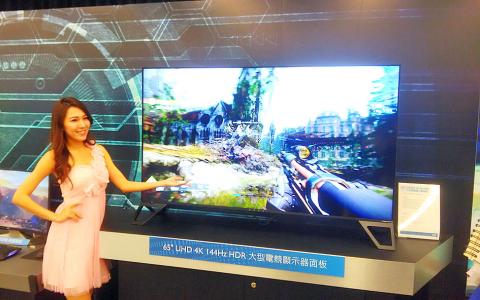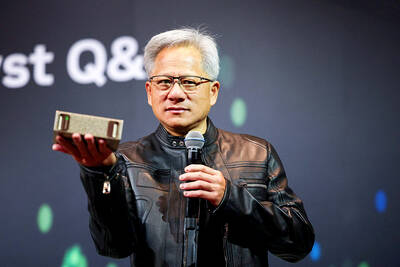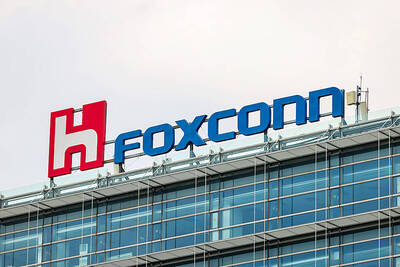AU Optronics Corp (AUO, 友達光電) yesterday said it is working with clients to offer flexible displays for their new foldable phones, likely later this year, an early sign that the industry is embracing such dual-screen phones for lack of major killer features.
That could be a breakthrough for the LCD panel maker, which has been supplying OLEDs for smaller devices, mostly wearables, in the past few years.
AUO’s remarks came after the world’s two biggest mobile phone companies — South Korea’s Samsung Electronics Co and China’s Huawei Technologies Co (華為) — recently showcased their latest foldable phones, the Galaxy Fold and Mate X respectively.

Photo: CNA
Such foldable phones “are a novelty that adopts display technologies in a new way and make such phones a new hybrid of mobile phones and tablets,” AUO chairman Paul Peng (彭双浪) told a media briefing.
“AUO has been putting resources in developing such displays. Hopefully we will see AUO’s flexible displays used in new foldable phones from branded vendors in 2019,” he said.
Unlike Huawei’s out-folding display, AUO has focused on in-folding displays, which have higher technological barriers, Peng said.
AUO plans to produce OLEDs at a 4.5-generation plant in Singapore for foldable phones, ordinary mobile phones and wearable devices.
Foldable phones are a “breakthrough,” but it remains to be seen how consumers will react to their high prices, and it would take time to see an uptake in such phones, Peng said.
The Galaxy Fold and Mate X have been priced at about US$2,000.
Samsung said the Galaxy Fold, which has a 7.3-inch main display and a 4.6-inch cover display, would reach stores next quarter.
New orders have started to trickle in after supply chain inventories were falling to healthy levels after the Lunar New Year holiday, and it has also received some orders that were shifted away from peers that have hit bottlenecks in boosting production, AUO said.
The order outlook for next quarter seems positive, which would push its factory utilization to almost 100 percent, it said.
AUO, which posted its first quarterly losses last quarter due to an overcapacity-driven industry slump, said oversupply would become a norm and it was increasing proportions of value-added products in its product lineup.
The value-added products, which include 85-inch ultra-high-definition 8K TV panels and flat panels for gaming PCs, would account for 50 percent of its revenue, AUO said.

SEEKING CLARITY: Washington should not adopt measures that create uncertainties for ‘existing semiconductor investments,’ TSMC said referring to its US$165 billion in the US Taiwan Semiconductor Manufacturing Co (TSMC, 台積電) told the US that any future tariffs on Taiwanese semiconductors could reduce demand for chips and derail its pledge to increase its investment in Arizona. “New import restrictions could jeopardize current US leadership in the competitive technology industry and create uncertainties for many committed semiconductor capital projects in the US, including TSMC Arizona’s significant investment plan in Phoenix,” the chipmaker wrote in a letter to the US Department of Commerce. TSMC issued the warning in response to a solicitation for comments by the department on a possible tariff on semiconductor imports by US President Donald Trump’s

‘FAILED EXPORT CONTROLS’: Jensen Huang said that Washington should maximize the speed of AI diffusion, because not doing so would give competitors an advantage Nvidia Corp cofounder and chief executive officer Jensen Huang (黃仁勳) yesterday criticized the US government’s restrictions on exports of artificial intelligence (AI) chips to China, saying that the policy was a failure and would only spur China to accelerate AI development. The export controls gave China the spirit, motivation and government support to accelerate AI development, Huang told reporters at the Computex trade show in Taipei. The competition in China is already intense, given its strong software capabilities, extensive technology ecosystems and work efficiency, he said. “All in all, the export controls were a failure. The facts would suggest it,” he said. “The US

The government has launched a three-pronged strategy to attract local and international talent, aiming to position Taiwan as a new global hub following Nvidia Corp’s announcement that it has chosen Taipei as the site of its Taiwan headquarters. Nvidia cofounder and CEO Jensen Huang (黃仁勳) on Monday last week announced during his keynote speech at the Computex trade show in Taipei that the Nvidia Constellation, the company’s planned Taiwan headquarters, would be located in the Beitou-Shilin Technology Park (北投士林科技園區) in Taipei. Huang’s decision to establish a base in Taiwan is “primarily due to Taiwan’s talent pool and its strength in the semiconductor

French President Emmanuel Macron has expressed gratitude to Hon Hai Precision Industry Co (鴻海精密) for its plan to invest approximately 250 million euros (US$278 million) in a joint venture in France focused on the semiconductor and space industries. On his official X account on Tuesday, Macron thanked Hon Hai, also known globally as Foxconn Technology Group (富士康科技集團), for its investment projects announced at Choose France, a flagship economic summit held on Monday to attract foreign investment. In the post, Macron included a GIF displaying the national flag of the Republic of China (Taiwan), as he did for other foreign investors, including China-based